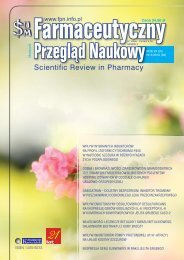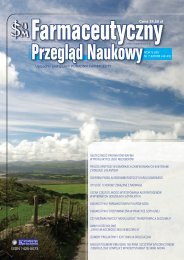Pokaż caÅy numer - FPN - Farmaceutyczny PrzeglÄ d Naukowy
Pokaż caÅy numer - FPN - Farmaceutyczny PrzeglÄ d Naukowy
Pokaż caÅy numer - FPN - Farmaceutyczny PrzeglÄ d Naukowy
Create successful ePaper yourself
Turn your PDF publications into a flip-book with our unique Google optimized e-Paper software.
Farm Przegl Nauk, 2009,8<br />
incubation time up to 24 h in low glucose DMEM resulted in<br />
an appearance of slight band corresponding to ORP150 (lane<br />
4). The prolongation of incubation in low glucose DMEM<br />
up to 48 h resulted in intensification of ORP150 whereas the<br />
expression of GRP170 was slightly reduced (lane 6).<br />
Fig. 4 shows the presence of gelatinolytic activity in<br />
the cell culture lysates. The cells cultured for 12 h in high<br />
glucose DMEM (lane 1) as well as in low glucose DMEM<br />
(lane 3) have shown an enzyme which corresponds to the<br />
zymogen form of MMP-2 this being activated under the action<br />
of SDS. The treatment with APMA did not evoke any<br />
change in electrophoretic activity of this enzyme (lanes: 2<br />
and 4). No MMP-9 has been detected.<br />
Extending the incubation up to 24 h in high glucose did<br />
not evoke any change in electrophoretic activity of this enzyme<br />
(lanes: 5 and 6). In contrast to them in the cells cultured<br />
in low glucose an intensification of pro-MMP-2 bands and<br />
appearance of an MMP-2 active form (lane 7 and 8) have<br />
been observed. Furthermore, a slight expression of both<br />
pro-MMP-9 and active MMP-9 was detected. The action<br />
of APMA did not evoke further increase in MMP-2 activity<br />
(lane 8). Extending the incubation of cells in high glucose<br />
up to 48 h resulted in a slight intensification of pro-MMP-2<br />
bands (lane 9 and 10). In contrast to them in the cells cultured<br />
in low glucose DMEM for 48 h further increase of<br />
MMP-2 expression has been observed. Bands corresponding<br />
to both pro-MMP-2 and active MMP-2 became much<br />
more intensive (lanes 11 and 12). Furthermore, an intensification<br />
of bands corresponding to pro-MMP-9 and active<br />
MMP-9 was apparent (Fig. 4).<br />
This study suggests that<br />
glucose may exert additional<br />
effect. It stimulates<br />
collagen biosynthesis,<br />
whereas glucose<br />
deprivation evokes up<br />
regulation of chaperones,<br />
which protect<br />
newly synthesised collagen<br />
against intracellular<br />
degradation.<br />
It is well known that<br />
collagen is the major human<br />
protein which contains<br />
hydroxyproline.<br />
In contrast to other proteins<br />
it is specifically digested<br />
by bacterial collagenase.<br />
For these reasons<br />
the incorporation<br />
of radiolabeled proline<br />
into collagenase-sensitive and hydroxyproline-containing<br />
protein is used as an index of collagen synthesis, whereas<br />
pulse-chase technique allows evaluating the degradation of<br />
newly synthesised protein [19].<br />
Fig. 4. Gelatinolytic activity of fibroblasts cultured in high glucose (H) and low glucose (L) DMEM for 12,<br />
24 and 48 h, without APMA (-), with APMA (+). All samples submitted to zymography contained 30 μg of<br />
protein.<br />
APMA - p-aminophenylmercuric acetate.<br />
We decided to study the effect of glucose deprivation<br />
on total protein/ collagen synthesis and degradation in fibroblast<br />
cultures, and correlation of these processes with the<br />
expression of oxygen/glucose-regulated proteins (ORP150/<br />
GRP170) and gelatinolytic activity. It was demonstrated that<br />
fibroblasts incubated in high glucose DMEM synthesised<br />
detectable amounts of collagenous proteins. They constituted<br />
a few per cent of total radioactive proteins. The shortage<br />
of glucose resulted in about 50% decrease in total protein<br />
and about 30% reduction in collagenase-sensitive and<br />
hydroxyproline-containing protein synthesis. The pulsechase<br />
experiment demonstrated that degradation rate of<br />
newly synthesised total protein did not change in response to<br />
glucose deprivation. Both in control and glucose-deprived<br />
cultures above 40% of radioactive proline incorporated into proteins<br />
in the pulse period were degraded during the chase phase.<br />
In contrast to that, the degradation of collagen in chase<br />
period depended on the presence of glucose in culture medium.<br />
Despite the cells incubated in low glucose medium<br />
synthesised less collagen in pulse period, they protected<br />
newly synthesised collagen against degradation in chase<br />
phase. Proportionally less collagen was degraded in cultures<br />
incubated in low glucose than in high glucose media despite<br />
of increased gelatinolytic activity after 24 or 48 h. These<br />
phenomena were accompanied by an increase in expression<br />
of ORP150 in cultures growing in low glucose medium.<br />
Discussion<br />
Glucose is commonly used therapeutic agent. In common<br />
opinion, intravenous administration of this sugar supplements<br />
the pool of energetic substrates in human body.<br />
The mechanism of decreased collagen synthesis at the<br />
conditions of glucose deprivation is easy to explain. No<br />
doubt, the shortage of the main energetic substrate in culture<br />
medium decreases ATP-formation and reduces all energyrequiring<br />
anabolic processes within the cells. It is more dif-<br />
36
















